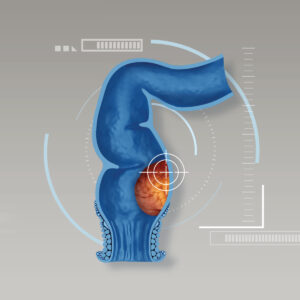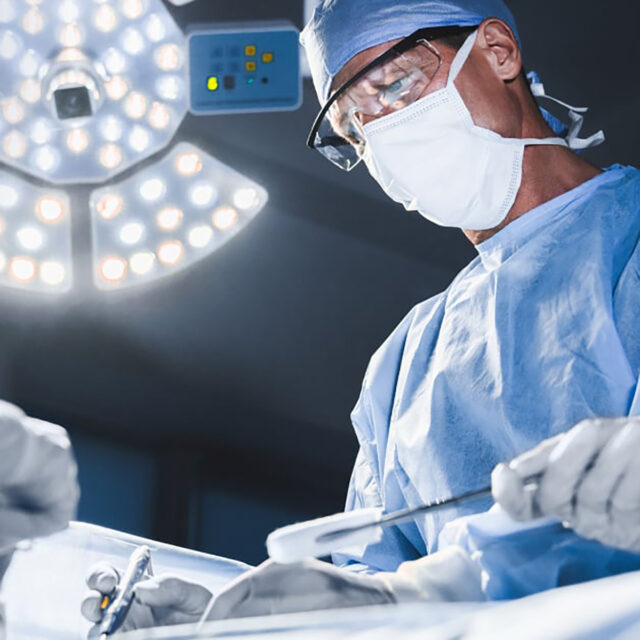Hemorrhoids, one of the most common health problems are often diagnosed due to rectal bleeding. Hemorrhoids can develop from increased pressure in the lower rectum due to straining during bowel movements. Nevertheless, colorectal cancer can also cause rectal bleeding. Due to the similarity of manifestations, patients are often confused, leading to delayed diagnosis and ineffective treatments. Therefore being aware of the specific warning signs and symptoms results in early detection and appropriate treatments.
Get to know “hemorrhoids”
Hemorrhoids are swollen veins in the anus and lower rectum. The veins around the anus tend to stretch under pressure, causing bulge or swelling. This condition can develop due to increased pressure in the lower rectum caused by certain conditions. Hemorrhoids might develop in different locations at the same time. Classified by locations, there are 2 types of hemorrhoids:
1. Internal hemorrhoids
Internal hemorrhoids lie inside the rectum, located above the pectinate line. Internal hemorrhoids are covered with cells that are the same as those that line the rest of the intestines. Internal hemorrhoids cannot be typically seen or felt. Only using special devices e.g. anoscopy, proctoscopy and sigmoidoscopy allows specialists to examine the inner lining of the rectum. Internal hemorrhoids can be stratified into 4 grades: from grade I to grade IV in which hemorrhoid protrudes and it cannot be pushed back in place, causing rectal discomfort, pain and bleeding.
2. External hemorrhoids
External hemorrhoids are hemorrhoids that affect veins outside the anus. External hemorrhoids arise below the pectinate line and are covered with cells that resemble skin which are typically slightly less pink than the surrounding skin. External bulges can be seen and touched around the anal area. Symptoms might include itching or irritation in the anal region, pain or discomfort, swelling around the anus and rectal bleeding.
Risk factors of hemorrhoids
Hemorrhoids can develop from increased pressure in the lower rectum due to:
- Straining during bowel movements;
- Frequent bowel movements;
- Sitting for long periods of time on the toilet;
- Having chronic diarrhea or constipation;
- Advanced age that makes tissues supporting the veins in rectum and anus become weak;
- Chronic cough;
- Regular heavy lifting; or
- Being pregnant when baby puts pressure on the anal region.
Signs and symptoms of hemorrhoids
Hemorrhoids typically manifest symptoms include:
- Presence of swelling or discomfort in the anal region;
- Hemorrhoids with bulge might be palpable inside the anus;
- Pain in the anal region;
- Itchy or irritation in the anal region; and
- Rectal bleeding seen on tissue paper or in the toilet bowl
Diagnosis of hemorrhoids
Diagnosing hemorrhoids usually include the examination of the anal canal and rectum. Tests and procedures are digital examination by inserting a gloved, lubricated finger into the rectum and identifying abnormal signs, visual inspection to examine the lower portion of the colon and rectum with special devices e.g. anoscope and other imaging tests such as ultrasonography and computerized tomography scan (CT).
Treatment of hemorrhoids
Selected treatment options entirely depend on presenting symptoms and disease severity as well as individual conditions of the patients. Treatment options include:
1. Non-surgical approaches: consist of
- Regular warm bath or sitz bath helps soothing the irritation from hemorrhoids.
- Medications such as rectal suppositories or ointments.
- Rubber band ligation. During procedure, one or two tiny rubber bands are placed around the base of an internal hemorrhoid to cut off its circulation. The hemorrhoid withers and falls off within a week.
Hemorrhoid banding can be uncomfortable and cause bleeding, therefore it should be performed by highly experienced specialists in order to reduce risks of serious complications. - Injection (sclerotherapy). A chemical solution is injected into the hemorrhoid tissue in order to shrink it by damaging blood vessels and reducing the blood supply to the hemorrhoids. The interval for injection is very 2-4 weeks.
2. Surgical approaches:
If non- surgical procedures failed or patients have large hemorrhoids that cannot be pushed in place, surgery is highly recommended. Types of surgery is determined by sizes and types of hemorrhoids as well as locations. Surgical options are:
- Open hemorrhoidectomy: An open hemorrhoidectomy is surgery to remove internal or external hemorrhoids that are extensive, large or severe.
- Stapled hemorrhoidectomy: Stapled hemorrhoidectomy is mostly used in patients with extensive hemorrhoids. During stapled hemorrhoidectomy, a circular stapling device is used to excise a circumferential ring of excess hemorrhoid tissue, thereby lifting hemorrhoids back to their normal position within the anal canal. Stapling also disrupts hemorrhoid blood supply. Studies have suggested that stapled hemorrhoidectomy results in less post-operative pain and shorter recovery compared with conventional surgery.
- Laser hemorrhoidectomy: Hemorrhoid laser procedure is a new laser procedure for treatment of hemorrhoids in which hemorrhoidal blood flow feeding the hemorrhoidal plexus is stopped by laser coagulation. It is recommended in hemorrhoids with mild stage while the size is still small. This procedure causes less pain, faster recovery time and fewer post-operative complications or side effects.
Recently, radiofrequency coagulation, a novel technique has been widely used to treat hemorrhoids. Initially, radiofrequency coagulation is used to treat patients diagnosed with liver cancer. This technique, combined with local anesthesia, has been adapted to treat patients with hemorrhoids. In radiofrequency ablation, the pile mass is directly coagulated by special form of energy, facilitating the immediate disappearance of the hemorrhoid. Radiofrequency coagulation also helps in tethering the mucosa to the rectal wall. In addition, radiofrequency coagulation can also strengthen sphincter muscle, resulting in improved outcomes in patients with fecal incontinence.. Nevertheless, this technique is not considered “laser treatment”. In fact, this is more advanced with superior treatment outcomes including less pain, lowered complications and faster recovery time. Since this procedure is “day surgery”, patients are able to return home on the same day after procedure is performed.
Rectal bleeding might indicate colorectal cancer
Not only hemorrhoids, colorectal cancer can also cause rectal bleeding. Due to the similarity of manifestations, patients are often confused, leading to delayed diagnosis and ineffective treatments. Colorectal cancer is defined as cancerous mass that is discovered inside the anus. Typical signs and symptoms include rectal bleeding that usually found in the stools, irregular size and appearance of stools (smaller than usual size), constipation, bowel movements with a feeling of incomplete defecation, alterations of diarrhea and constipation, abdominal pain or cramp, fatigue and unintentional weight loss.
If there is the presence of rectal bleeding, immediate medical care must be provided in order to get it accurately diagnosed, resulting in timely and effective treatments.











